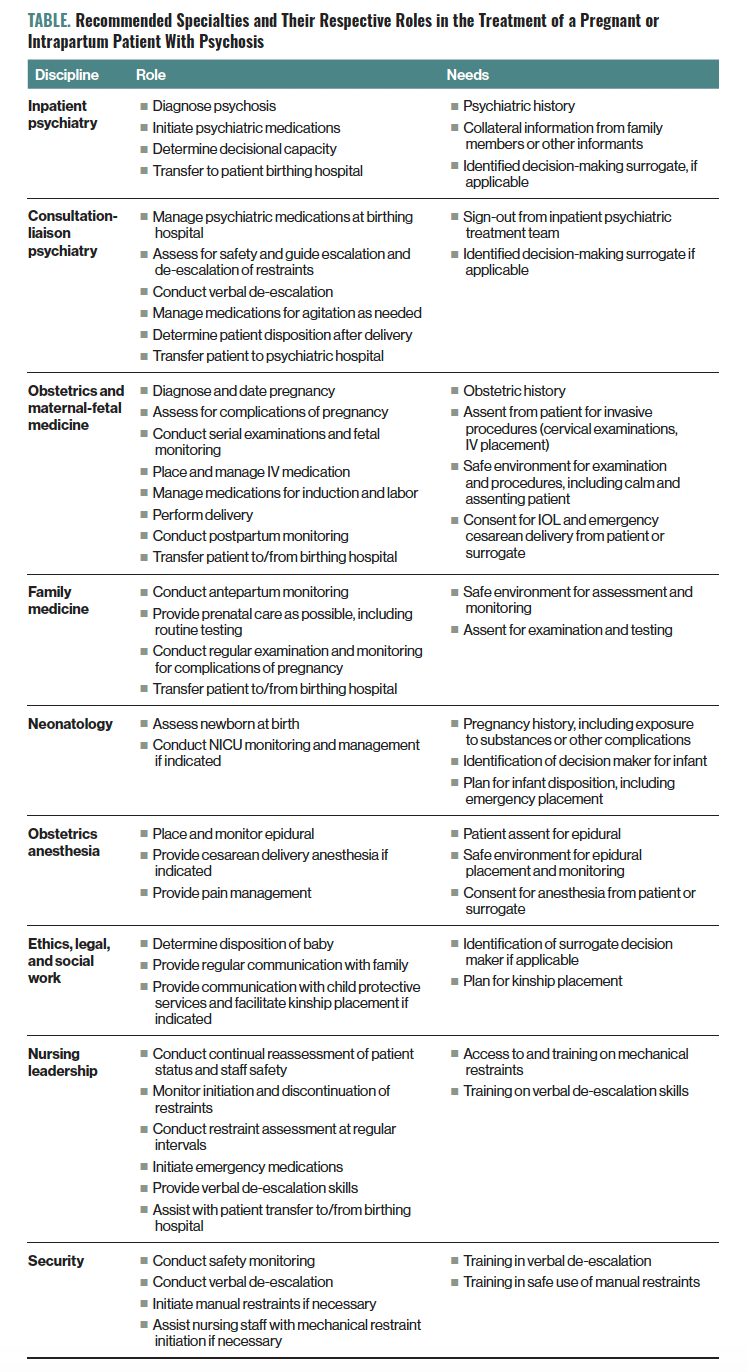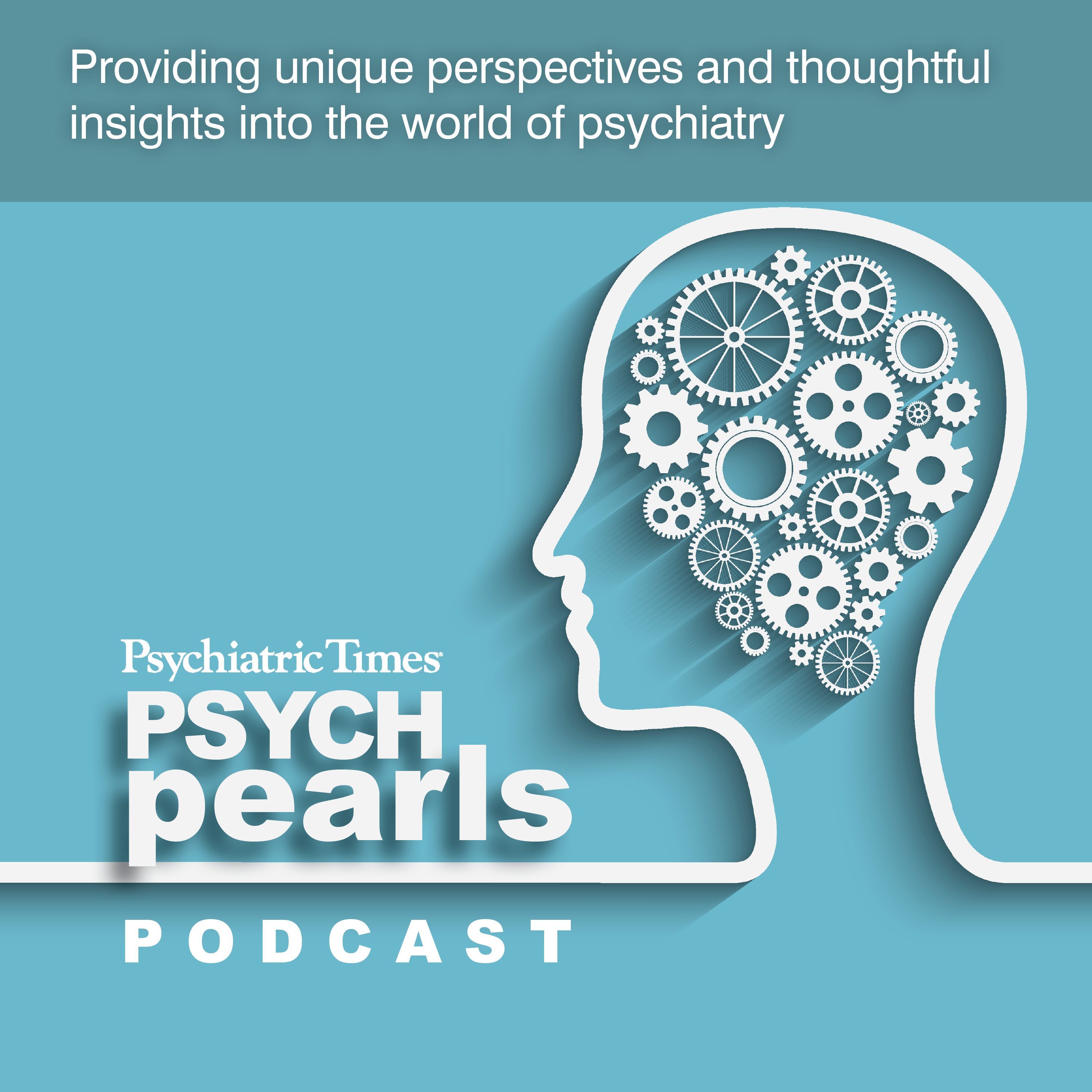Publication
Article
Psychiatric Times
Examining a Case of Acute Late-Pregnancy Psychosis: How Best to Coordinate Care
Author(s):
Key Takeaways
- Pregnancy can worsen psychiatric disorders, with peripartum psychosis being a psychiatric emergency due to self-harm risks and adverse obstetric outcomes.
- Induction of labor may be necessary when psychosis impairs decision-making capacity, requiring surrogate decision-making and interdisciplinary care.
Peripartum psychosis is considered a psychiatric emergency. Here is how an interdisciplinary team can provide the best care.
Laia Balart/AdobeStock

Pregnancy is a period of heightened vulnerability in patients with psychiatric disorders.1 Although antepartum-onset psychosis is rare, primary psychotic and bipolar disorders often worsen during pregnancy and peripartum psychosis may manifest in late pregnancy.2,3 In addition to organic factors, pregnancy may affect psychosocial factors such as sleep, nutrition, and interpersonal stressors, which can worsen preexisting psychotic disorders.4 Peripartum psychosis is considered a psychiatric emergency due to elevated risks of self-harm and, rarely, infanticide.5 Psychotic and bipolar disorders are also associated with risks for adverse obstetric outcomes, including preeclampsia, gestational diabetes, preterm birth, and neonatal intensive care unit (NICU) admission.6-8 Early identification and management are critical for safe outcomes for the mother and fetus. Some literature exists to guide ethical and clinical management of pregnant patients with severe mental illness, but no published clinical data exist on the application of this approach in the emergency treatment of the patient with psychosis or the success of significant treatment interventions in absence of capacity.9-11 Thus, there is little direct clinical guidance for these challenging situations.
Induction of labor (IOL) is generally indicated when risks of continued expectant management outweigh the risks of labor and delivery.12 Although psychosis itself is not an indication for IOL, delivery may be complicated by increased risks due to agitation or inability to care for oneself.13 Pregnant patients with psychosis may lack the capacity to consent to IOL and associated procedures, but awaiting spontaneous labor may result in poorer obstetric outcomes.14 Thus, a planned IOL, potentially with consent through a surrogate decision maker, may be the safest and most ethical course of action. In such a situation, an organized and coordinated plan of care involving an interdisciplinary team with careful forethought and good communication between all care team members and with the patient’s surrogate decision maker is most likely to result in the safest outcome for all parties.
Case Study
“Ms Clark” is a 30-year-old woman (gravida 4, para 2) with a history of unspecified schizophrenia spectrum disorder, borderline intellectual functioning, and polysubstance (opiate, cocaine, benzodiazepine, cannabis, and alcohol) use who was transported to a local emergency department after she was apprehended by police for entering an active crime scene. She demonstrated altered mental status and erratic behaviors, including aggression and suicidal statements. Pregnancy was detected via human chorionic gonadotropin blood test and ultimately dated at approximately 38 weeks by ultrasound. Blood alcohol concentration was .058, but Ms Clark refused drug testing. She repeatedly threatened and assaulted staff members, necessitating the use of mechanical restraints and intramuscular haloperidol, lorazepam, and diphenhydramine due to safety concerns.
Ms Clark was admitted to the psychiatric hospital with provisional diagnoses of substance-induced psychotic disorder vs unspecified psychotic disorder. Review of available records was notable for 8 prior psychiatric hospitalizations for similar presentations, lack of long-term psychiatric follow-up, and no prenatal care. Hospitalization was complicated by aggression toward staff and herself, necessitating restraints and emergency administration of intramuscular haloperidol on a near daily basis. She was initiated on nightly haloperidol 2 mg in the second week of hospitalization without substantial improvement. Due to continued danger to herself, her fetus, and staff, preparations were made for a planned IOL at 39 weeks gestation and coordination of care meetings was initiated.
Critical patient safety and ethical considerations were assessed, and roles were assigned to the appropriate teams. Ms Clark was unable to engage in conversations regarding her understanding of the IOL, including risks and benefits, and she was determined not to have the capacity for complex decision-making regarding childbirth. Her mother was identified as her surrogate decision maker and consented to IOL and emergency cesarean delivery if needed.
Ms Clark was transferred to the women’s hospital at 39 weeks gestation, where she was frequently assessed by the psychiatry consultation service. She initially required 4-point mechanical restraints, which were de-escalated to 2 points, but due to ongoing physical threats to staff, they were not de-escalated further. She received 1 mg intravenous push of lorazepam, but predelivery agitation was otherwise managed nonpharmacologically (although she did receive haloperidol/lorazepam once post delivery and after transfer). With the therapeutic presence of her mother at her bedside, Ms Clark became calmer and assented to IOL and associated procedures. She had uncomplicated vaginal delivery 20 hours after transfer. The newborn was examined by the neonatology team, who did not find significant complications of labor or evidence of neonatal abstinence syndromes necessitating NICU admission. Child protective services were contacted following delivery per state laws, and an emergency custody agreement for kinship placement was received from the courts.
Ms Clark was transferred back to the psychiatric hospital approximately 16 hours after delivery. She remained in inpatient care for 8 days, where she was initiated on standing risperidone and showed significant improvement in symptoms with resolution of aggression, improved mood lability, and increased participation in psychiatric interviews. She attained psychiatric stability for an outpatient level of care and was discharged to the care of the family 16 days after her initial admission.
Discussion
Acute psychosis in late pregnancy is a challenge to obstetric and psychiatric management. Obstetricians may feel obligated to delay certain procedures or pursue nonpreferred approaches (eg, cesarean delivery) due to unfamiliar factors such as agitation or lack of decision-making capacity, whereas psychiatric teams may feel limited in pharmacological and nonpharmacological management options due to the presence of pregnancy. The result may be poorer clinical outcomes or patients receiving nonstandard obstetric care.7,11 Our case illustrates that with early involvement of critical specialties and careful coordination between team members, high-quality obstetric care can be provided with good outcomes.
Interdisciplinary Care Planning
Our primary recommendation is that when a case of late-pregnancy psychosis is identified, stakeholders should convene to determine a multidisciplinary plan of care that includes a birthing plan, psychiatric treatment plan, determination of decisional capacity, and disposition of mother and newborn. We advocate that an obstetric standard of care should be attempted in every case. See the Table for proposed guidelines for team member roles. Every patient scenario will be different, and each should involve an individualized risk-benefit discussion and determination of feasible clinical goals. This approach is consistent with published recommendations for managing pregnancy in other forms of severe mental illness.11
TABLE. Recommended Specialties and Their Respective Roles in the Treatment of a Pregnant or Intrapartum Patient With Psychosis

Diagnostic Considerations
Making the diagnosis of acute psychosis in pregnancy may be challenging even to seasoned clinicians, and very little published research exists for guidance. Nosology of peripartum psychosis is controversial, with some experts purporting this condition to be a discrete diagnostic entity.4 Peripartum psychosis is strongly associated with bipolar disorder and often presents with severe affective disturbances such as mania, irritability, or depression.15 A prior history of bipolar disorder is the most important known risk factor.16 Onset of symptoms is most frequently in the postpartum period, but may begin, as in the case of Ms Clark, in the late antepartum period as well.3
An additional diagnostic consideration is the differentiation of a primary vs substance-induced psychotic disorder, which may remit spontaneously with the removal of the offending substance.17 The lack of significant symptom remission within 48 to 72 hours of last use should trigger careful consideration of a primary psychotic disorder. Any new diagnosis of psychosis in a pregnant patient must warrant appropriate medical workup to rule out potential organic causes such as acute infection or metabolic disturbances.18 Overall, the most critical clinical question is whether a patient’s symptoms require initiation of antipsychotic treatment. We recommend early involvement of the psychiatry consultation team when psychosis is suspected in a pregnant patient to assist with diagnosis and help guide management.
Determination of Decisional Capacity
Determination of decisional capacity poses unique challenges for patients with psychosis in the peripartum period. Helpfully, previous literature has reviewed ethical guidelines and useful algorithms for decision-making in pregnant patients with impaired capacity.9,10 First, patients with psychosis are not presumed incapacitated by default, and management is aimed at restoring capacity when possible.19 The mainstays of treatment include antipsychotics and electroconvulsive therapy,1,20 especially when delaying care could have negative or life-threatening consequences. When capacity cannot be restored, the next step is substituted judgment based on a patient’s premorbid treatment preferences. Ideally, these are determined during antenatal treatment or gleaned from a surrogate decision maker who knows them. If the patient’s preferences are not known or an emergency situation precludes information gathering, clinicians should act in the best interests of the patient and fetus. The patient’s assent should be sought and measures taken to facilitate acceptance and tolerability of treatment, including verbal interventions such as explaining the treatment, familiarizing and comforting the patient as much as possible, including family or trusted others at their bedside, and treating agitation. Coerced treatment should be undertaken only as a last resort when there are imminent safety concerns.
In our case, decision-making capacity could not be restored prior to delivery despite attempts to do so; a surrogate decision maker was contacted to provide the best care in the swiftest manner. In her case, certain factors simplified decision-making: (1) readily available presence of an appropriate surrogate decision maker, (2) gestational age of 39 weeks when benefits of IOL begin to outweigh expectant management,14 and (3) no obstetric contraindications to IOL. Cases lacking these factors may have different risk-benefit assessments and may benefit from involvement of legal counsel or medical ethics teams.
Newborn Considerations
A related ethical issue is the consideration of child placement and well-being after delivery. In the case of Ms Clark, child protective services intervened to place the child with the patient’s sister based on their independent assessment. In other cases, family may not be available for kinship placement or placement may not be indicated. Child protective services should be contacted per mandatory reporter guidelines if questions arise about the safety of the newborn. We recommend early and continuous involvement of the patient’s family when possible and indicated.
Agitation Management
Peripartum psychosis can be associated with both agitation and aggression.21 Current guidelines on the management of agitation emphasize using verbal de-escalation first, with consideration of pharmacological and mechanical restraints only for imminent safety concerns.22 The type of restraint used should be the least restrictive available that can maintain safety, and restraints should be discontinued as soon as safely possible.23 Use of restraints must be accompanied by ongoing risk-benefit analysis and frequent reassessment of patient and staff safety. This process should be collaborative between obstetrical teams, psychiatry, floor staff, and security, all whom can monitor patient status and staff safety. Restraints should be de-escalated as soon as a patient is no longer agitated or aggressive and not interfering with medical care in ways that compromise safety. Efforts must also be made to address agitation by addressing needs where possible (eg, pain), use of verbal de-escalation, and inclusion of support persons such as family members.
In the case of Ms Clark, extensive efforts were made at verbal de-escalation by staff, the psychiatry team, and the patient’s mother. Despite these efforts, Ms Clark remained consistently aggressive toward staff and hospital equipment, and additional means of treatment were necessary to ensure safety. Due to risks of oversedation on labor, fetal adverse effects of medication, and the potential trauma of intramuscular administration of medications, mechanical restraints were chosen over multiple rounds of medications as needed. Continual attempts at removing restraints during IOL were unsuccessful. Frequent discussions with bedside staff and the involved care teams allowed for communication about ethical questions that arose about this issue. In our case, this decision was taken with consideration of what was least likely to cause harm to the patient and staff. Ms Clark ultimately tolerated the restraints well, and only a single dose of medication for agitation (ie, lorazepam) was required during IOL, without evidence of neonatal abstinence or morbidity to the newborn after birth.
Intrapartum Pain Management
Pain management is a necessary aspect of intrapartum care but warrants additional consideration in patients with psychosis. Pain may both exacerbate and be complicated by acute agitation. Patients with severe mental illness may have difficulty communicating their pain and may lack capacity to participate in decisions about pain management.
Patient-controlled epidural analgesia (PCEA) is generally considered the gold standard for labor analgesia due to its efficacy, flexibility, and reduced overall dosage of anesthetics.24 Given the increased risks associated with general anesthesia compared with neuraxial anesthesia, the current standard of care is to avoid general anesthesia when possible in the obstetric population. In this case, Ms Clark was able to communicate her pain and assented to PCEA. A multidisciplinary team with the psychiatrist, obstetrician, and anesthesiologist should discuss pain management strategies as part of delivery planning on a case-by-case basis. Even in a patient without capacity, shared decision-making and advanced planning of pain management allow for evidence-based care and ended up leading to the safest plan with our patient.
Potential Complications
A final point of management is the early consideration of potential complications, including the need for an emergency cesarean delivery.10,11,14 Consideration of IOL in a pregnant patient with acute psychosis must include provisions for this possibility, including ideally obtaining consent prospectively from the patient or surrogate decision maker per standard of care. The same is true for any possible emergency obstetric complications, such as hemorrhage requiring transfusion, treatment of the newborn, and the potential of newborn morbidity. One major neonatal consideration is the effects of medications used for agitation on the neonate, including potential for neonatal abstinence syndrome or respiratory depression. For this reason, we recommend early involvement of the neonatology team in labor planning.
Concluding Thoughts
This complicated and challenging case ultimately resulted in a good clinical outcome for both the mother and the newborn. Care was thoroughly coordinated between multiple specialties, and a plan of delivery was proactively developed and implemented. Consideration of both practical and ethical concerns enabled shared decision-making between the patient’s surrogate, the inpatient psychiatric team, and inpatient obstetrical treatment team, all with psychiatric consultation on a nonemergency basis. This interdisciplinary approach provides a useful treatment framework for future cases.
Dr Westbrook is a board-certified psychiatrist in Pittsburgh, Pennsylvania, affiliated with University of Pittsburgh Medical Center (UPMC) Presbyterian.
Dr Spada is an assistant professor of psychiatry at the University of Pittsburgh. She is an associate program director for the psychiatry residency program at UPMC. She is also codirector of the residency program’s academic administrator clinician educator track and codirector of the women’s mental health and reproductive psychiatry area of concentration. Dr Hovis is an assistant professor of psychiatry at the Medical College of Wisconsin in Milwaukee.
Dr Larkin is an associate professor of obstetrics, gynecology, and reproductive sciences at the University of Pittsburgh. Dr Nicholas is an assistant professor of anesthesiology and perioperative medicine and the medical director of obstetric-cardiac anesthesiology at the University of Pittsburgh. Dr Swider is a psychiatrist in Pittsburgh. Dr Yadlosky is an assistant professor of family medicine and the medical director of Mathilda Theiss Health Center at the University of Pittsburgh. Dr DeRenzo is the chief anesthesiologist at Magee-Womens Hospital and an associate professor of anesthesiology and perioperative medicine at the University of Pittsburgh. Dr Dunmore is an obstetric anesthesiologist at Great Lakes Anesthesiology in Buffalo, New York. Dr Kloesz is a professor of pediatrics at the University of Pittsburgh School of Medicine and the director of the Division of Newborn Medicine. Ms Dudas is director of the Unit OB Specialties at UPMC. Mr Silipigni is an adjunct professor at the University of Pittsburgh. Dr Gopalan is an associate professor of psychiatry and of obstetrics, gynecology, and reproductive sciences in the Department of Psychiatry at the University of Pittsburgh.
Acknowledgments
The authors would like to acknowledge the numerous members of staff at psychiatric and obstetric hospitals, including in nursing, security, and transport, who enabled treatment of this patient. Minor details were changed to protect patient privacy.
References
1. Jones I, Chandra PS, Dazzan P, Howard LM. Bipolar disorder, affective psychosis, and schizophrenia in pregnancy and the post-partum period. Lancet. 2014;384(9956):1789-1799.
2. Karakasi MV, Markopoulou M, Tentes IK, et al. Prepartum psychosis and neonaticide: rare case study and forensic-psychiatric synthesis of literature. J Forensic Sci. 2017;62(4):1097-1106.
3. Chandra PS. The interface between psychiatry and women’s reproductive and sexual health. Indian J Psychiatry. 2001;43(4):295-305.
4. Perry A, Gordon-Smith K, Jones L, Jones I. Phenomenology, epidemiology and aetiology of postpartum psychosis: a review. Brain Sci. 2021;11(1):47.
5. Rodriguez-Cabezas L, Clark C. Psychiatric emergencies in pregnancy and postpartum. Clin Obstet Gynecol. 2018;61(3):615-627.
6. Judd F, Komiti A, Sheehan P, et al. Adverse obstetric and neonatal outcomes in women with severe mental illness: to what extent can they be prevented? Schizophr Res. 2014;157(1-3):305-309.
7. Frayne J, Nguyen T, Allen S, et al. Obstetric outcomes for women with severe mental illness: 10 years of experience in a tertiary multidisciplinary antenatal clinic. Arch Gynecol Obstet. 2019;300(4):889-896.
8. Dazzan P. Schizophrenia during pregnancy. Curr Opin Psychiatry. 2021;34(3):238-244.
9. McCullough LB, Chervenak FA, Coverdale JH. Managing care of an intrapartum patient with agitation and psychosis: ethical and legal implications. AMA J Ethics. 2016;18(3):209-214.
10. Babbitt KE, Bailey KJ, Coverdale JH, et al. Professionally responsible intrapartum management of patients with major mental disorders. Am J Obstet Gynecol. 2014;210(1):27-31.
11. Acera Pozzi R, Yee LM, Brown K, et al. Pregnancy in the severely mentally ill patient as an opportunity for global coordination of care. Am J Obstet Gynecol. 2014;210(1):32-37.
12. Tsakiridis I, Mamopoulos A, Athanasiadis A, Dagklis T. Induction of labor: an overview of guidelines. Obstet Gynecol Surv. 2020;75(1):61-72.
13. Friedman SH, Hall RCW, Sorrentino RM. Involuntary treatment of psychosis in pregnancy. J Am Acad Psychiatry Law. 2018;46(2):217-223.
14. Grobman WA, Caughey AB. Elective induction of labor at 39 weeks compared with expectant management: a meta-analysis of cohort studies. Am J Obstet Gynecol. 2019;221(4):304-310.
15. Osborne LM. Recognizing and managing postpartum psychosis: a clinical guide for obstetric providers. Obstet Gynecol Clin North Am. 2018;45(3):455-468.
16. Davies W. Understanding the pathophysiology of postpartum psychosis: challenges and new approaches. World J Psychiatry. 2017;7(2):77-88.
17. Wilson L, Szigeti A, Kearney A, Clarke M. Clinical characteristics of primary psychotic disorders with concurrent substance abuse and substance-induced psychotic disorders: a systematic review. Schizophr Res. 2018;197:78-86.
18. Wilson MP, Nordstrom K, Shah AA, Vilke GM. Psychiatric emergencies in pregnant women. Emerg Med Clin North Am. 2015;33(4):841-851.
19. Bourgeois JA, Tiamson-Kassab M, Sheehan KA, et al. Resource Document on Decisional Capacity Determinations in Consultation-Liaison Psychiatry: A Guide for the General Psychiatrist. American Psychiatric Association. June 2019. Accessed February 17, 2025. https://www.psychiatry.org/psychiatrists/search-directories-databases/resource-documents/2019/decisional-capacity-determinations-in-consultation
20. Armstrong C. ACOG guidelines on psychiatric medication use during pregnancy and lactation. Am Fam Physician. 2008;78(6):772-778.
21. Khushu A, Powney MJ. Haloperidol for long‐term aggression in psychosis. Cochrane Database Syst Rev. 2016;11(11):CD009830.
22. Holloman GH Jr, Zeller SL. Overview of Project BETA: best practices in evaluation and treatment of agitation. West J Emerg Med. 2012;13(1):1-2.
23. Knox DK, Holloman GH Jr. Use and avoidance of seclusion and restraint: consensus statement of the American Association for Emergency Psychiatry project BETA seclusion and restraint workgroup. West J Emerg Med. 2012;13(1):35-40.
24. Practice guidelines for obstetric anesthesia: an updated report by the American Society of Anesthesiologists Task Force on Obstetric Anesthesia and the Society for Obstetric Anesthesia and Perinatology. Anesthesiology. 2016;124(2):270-300.






